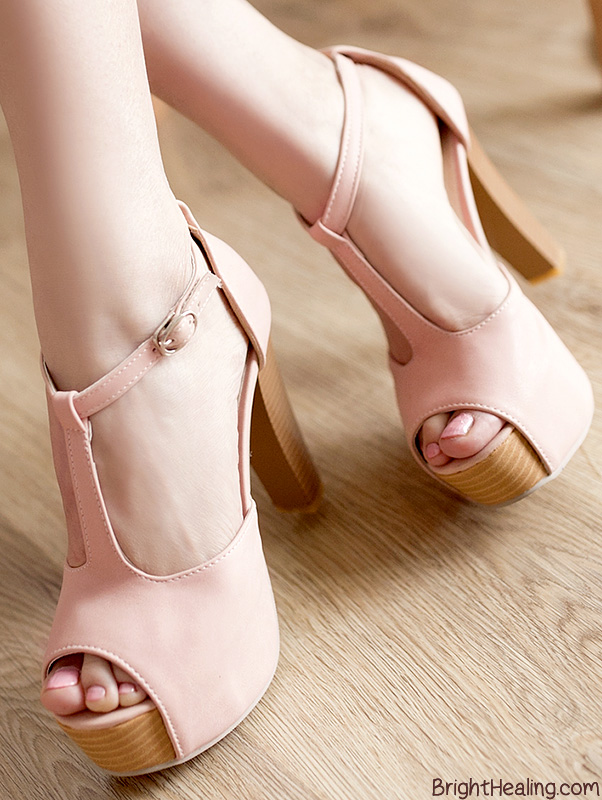Millions of women wear high heels almost every day. But what most don’t know is that they’re routinely putting themselves at risk of permanent physiological damage to their knees, hips, back and tendons. Yeah, high heels are cute, but these shoes can harm so much more than your feet.
The perfect, pointy pair of 4-inch heels can make any outfit, but with this style comes much suffering. High heels have the stigma of being bad for health and comfort, but this barely stops women from wearing them occasionally and often daily. Women often make sacrifices for foot fashion, but at what price?
Marilyn Monroe once said, “I don’t know who invented high heels, but all women owe him a lot.” But what she didn’t realize was that a lot of women can attribute whoever started this age-old trend to their health problems. Sky-high heels, too-low flats, arch-less flip-flops and pointy or wrong-sized shoes can cause deformed toes, painful bumps and bunions, inflamed nerves or bones, torn or overstretched ligaments, even hairline fractures.
Researchers at Griffith University in Queensland, Australia got the idea over a cup of coffee, while watching a young woman stumble past them in heels. “She looked quite uncomfortable and unstable,” Dr. Neil J. Cronin, a postdoctoral researcher at the university’s musculoskeletal research program, told The New York Times. “We began to consider what might be happening at the muscle and tendon level.”
For the study – published in the Jan. 12 issue of the Journal of Applied Physiology – Cronin and colleagues put 9 “habitual high heel wearers” to the test and studied their walking. These women wore two inch heels for at least 40 hours a week for a minimum of two years. The researchers compared their strides on a 26-foot platform with strides of 10 young women, who wore heels less than 10 hours per week. All the women ranged in age from their late teens to their early 30s, and were outfitted with electrodes and sensors to study their leg muscles.
What did the researchers find?
The daily high heel-wearers walked with shorter and more forceful strides, compared to the controls. The heel wearers were also found to constantly have their feet in a flexed, toes-pointed position – so much so, that it became “default” for their feet, Cronin told the Times. This position – along with the shortened stride – actually caused the women’s calf muscles to shorten, the study found, leading them to put more strain on their muscles
Cronin said that when these women will slip on more comfortable shoes like sneakers or flip-flops, they face an even greater injury risk since they’re introducing their permanently deformed feet into a different environment. And since the women in the study were young – 25, on average – the toll the heels take on feet may happen fairly quickly, and the impact could be even worse for older women.
That doesn’t surprise Dr. Orly Avitzur, medical adviser for Consumer Reports. She’s written about high heels dangers for years, and she told HealthPop that she’s heard from many women they simply can’t wear high heels once they reach their 40s because their feet are too damaged.
The physical dangers of wearing high heels should be kept into consideration when choosing the next pair.
1. Always choose comfortable high-heeled shoes. Consider high heeled shoes with an air bag or very comfortable sole that protects your feet from rubbing and provides shock absorption.
2. Choose to try on shoes at the end of your day, as they swell throughout the day when you stand and walk around.
3. Try on both pairs of shoes, as your feet may not be identical in size and the shoes may not be identical in size as well.
4. Limit your walking and standing when wearing high heels.
5. Stretch tight shoes with shoe stretchers to make them more comfortable.
6. Avoid running in high heels!
7. Have your legs and feet massaged after wearing high heels.
How to undo the damage
Yep, heels can affect your feet, hips, and back — but you can prevent pain with a few simple moves:
Work the hips. “The more flexible your hips are, the better you’ll be able to tolerate the stress that heels put on your body,” says Dr. Splichal. “Keep them limber by doing at least five minutes of hip flexor stretches before and after putting on high heels.”
Whip out a golf ball. And roll it under the ball, arch, and heel of your foot for five minutes in the morning and evening. This feel-good move massages feet and keeps them flexible.
Step it up. Stand on a step barefoot, letting your heels extend off the edge. With your weight on the balls of your feet, lower your heels down as far as you can, then rise up on your toes and slowly return to the starting position. Repeat for about 30 reps.
Flex your toes. Sit barefoot in a chair and loop a towel under the toes of your foot. Pull up gently on the ends of the towel, pulling your toes toward your chin. Repeat 10 times on each foot.
Write the alphabet. To strengthen your ankles and improve range of motion, use your big toe to trace each letter of the alphabet in cursive in the air, moving only the foot and ankle.
Make like a monkey. Place about 20 binder clips on the floor. Using your toes, pick up one at a time and drop it into a cup. This will stretch the bottoms of your feet.

